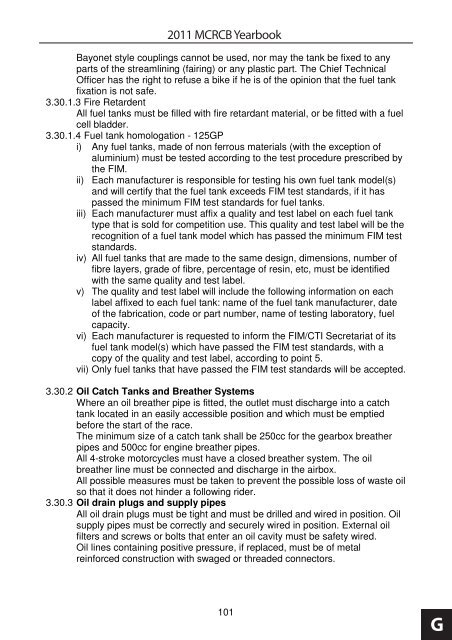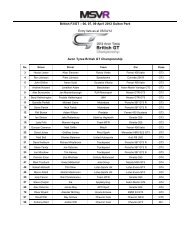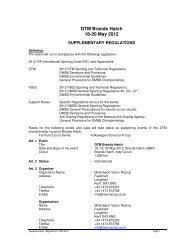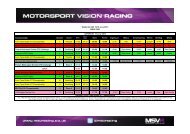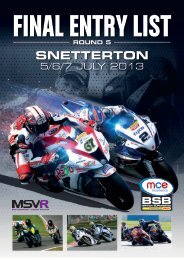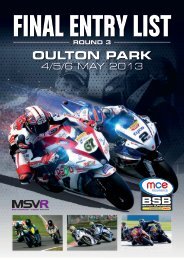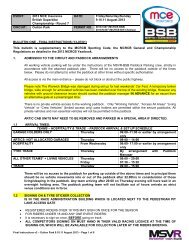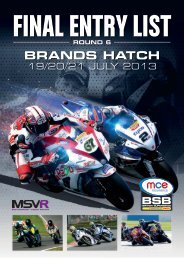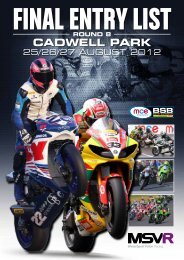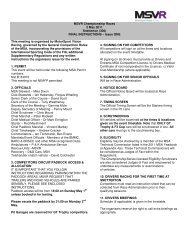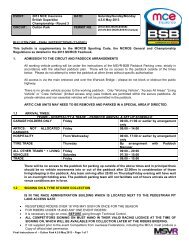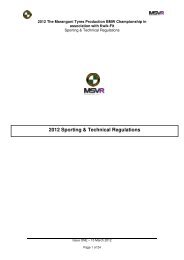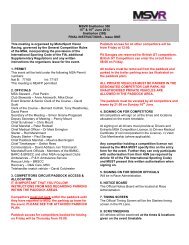E - MotorSport Vision Racing
E - MotorSport Vision Racing
E - MotorSport Vision Racing
Create successful ePaper yourself
Turn your PDF publications into a flip-book with our unique Google optimized e-Paper software.
2011 MCRCB Yearbook<br />
Bayonet style couplings cannot be used, nor may the tank be fixed to any<br />
parts of the streamlining (fairing) or any plastic part. The Chief Technical<br />
Officer has the right to refuse a bike if he is of the opinion that the fuel tank<br />
fixation is not safe.<br />
3.30.1.3 Fire Retardent<br />
All fuel tanks must be filled with fire retardant material, or be fitted with a fuel<br />
cell bladder.<br />
3.30.1.4 Fuel tank homologation - 125GP<br />
i) Any fuel tanks, made of non ferrous materials (with the exception of<br />
aluminium) must be tested according to the test procedure prescribed by<br />
the FIM.<br />
ii) Each manufacturer is responsible for testing his own fuel tank model(s)<br />
and will certify that the fuel tank exceeds FIM test standards, if it has<br />
passed the minimum FIM test standards for fuel tanks.<br />
iii) Each manufacturer must affix a quality and test label on each fuel tank<br />
type that is sold for competition use. This quality and test label will be the<br />
recognition of a fuel tank model which has passed the minimum FIM test<br />
standards.<br />
iv) All fuel tanks that are made to the same design, dimensions, number of<br />
fibre layers, grade of fibre, percentage of resin, etc, must be identified<br />
with the same quality and test label.<br />
v) The quality and test label will include the following information on each<br />
label affixed to each fuel tank: name of the fuel tank manufacturer, date<br />
of the fabrication, code or part number, name of testing laboratory, fuel<br />
capacity.<br />
vi) Each manufacturer is requested to inform the FIM/CTI Secretariat of its<br />
fuel tank model(s) which have passed the FIM test standards, with a<br />
copy of the quality and test label, according to point 5.<br />
vii) Only fuel tanks that have passed the FIM test standards will be accepted.<br />
3.30.2 Oil Catch Tanks and Breather Systems<br />
Where an oil breather pipe is fitted, the outlet must discharge into a catch<br />
tank located in an easily accessible position and which must be emptied<br />
before the start of the race.<br />
The minimum size of a catch tank shall be 250cc for the gearbox breather<br />
pipes and 500cc for engine breather pipes.<br />
All 4-stroke motorcycles must have a closed breather system. The oil<br />
breather line must be connected and discharge in the airbox.<br />
All possible measures must be taken to prevent the possible loss of waste oil<br />
so that it does not hinder a following rider.<br />
3.30.3 Oil drain plugs and supply pipes<br />
All oil drain plugs must be tight and must be drilled and wired in position. Oil<br />
supply pipes must be correctly and securely wired in position. External oil<br />
filters and screws or bolts that enter an oil cavity must be safety wired.<br />
Oil lines containing positive pressure, if replaced, must be of metal<br />
reinforced construction with swaged or threaded connectors.<br />
101<br />
G


